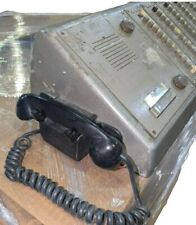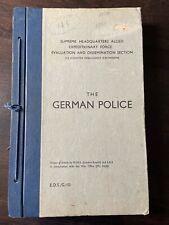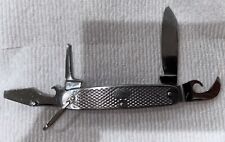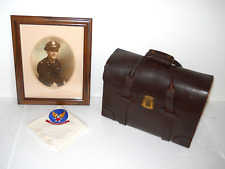|

On eBay Now...
RARE WWII D-Day 1944 Allied Dropped 1st Edition German Propaganda Leaflet For Sale

When you click on links to various merchants on this site and make a purchase, this can result in this site earning a commission. Affiliate programs and affiliations include, but are not limited to, the eBay Partner Network.

RARE WWII D-Day 1944 Allied Dropped 1st Edition German Propaganda Leaflet:
$701.25
Comes with hand-signed C.O.A. FULLY TRANSLATED This incredibly rare and museum-grade WWII Allied propaganda leaflet was dropped over German positions during the Battle for Brittany (Operation Cobra) which took place between August and October 1944. This very scarce 1st EDITION GREEN German surrender leaflet was one of the early WWII surrender leaflet series that was changed quickly with the help of D-Day and Normandy captured German P.O.W.s. This 1st EDITION leaflet was dropped after the Allies broke out of Normandy in June 1944. This is a once-in-a-lifetime opportunity to own this very scarce German surrender leaflet. The ZG37 leaflet was only dropped in France from August to September 1944. *These propaganda leaflets were saved by U.S. soldiers who were pushing through Normandy and France following the D-Day landings in June 1944. This propaganda leaflet shows amazing theater wear while still maintaining incredible condition. World War II witnessed unprecedented technological and strategic advancements in warfare, leading to the emergence of innovative tactics aimed at gaining an upper hand. One such strategy was the use of psychological warfare through the distribution of surrender leaflets to the enemy forces. This essay delves into the utilization and impact of Allied German surrender leaflets during and after the D-Day landings, with special emphasis on their role in Operation Cobra. Psychological Warfare and Surrender Leaflets: Psychological warfare involves influencing the mindset and morale of the enemy by employing non-lethal tactics. The distribution of surrender leaflets was an ingenious way of leveraging the enemy's mental state, exploiting their doubts and uncertainties. Allied forces, notably the United States and the United Kingdom, devised elaborate strategies to employ these leaflets effectively, aiming to induce confusion and doubt among German troops. D-Day and German Surrender Leaflets: The D-Day landings on June 6, 1944, marked a pivotal moment in World War II, as the Allies began their liberation of Western Europe. In the wake of these historic landings, the Allies initiated the distribution of surrender leaflets among the German forces, urging them to give up their resistance. These leaflets were often a combination of visual imagery and text, designed to appeal to the soldiers' sense of self-preservation and doubt about the success of the Axis cause. Operation Cobra: One of the most significant post-D-Day campaigns was Operation Cobra, launched on July 25, 1944. This offensive aimed to break through the German lines in Normandy and create a path for the Allies to advance rapidly. German forces, surrounded and under heavy bombardment, found themselves facing a critical decision point. The Allied command recognized this moment and capitalized on it by employing surrender leaflets as a psychological weapon. Role of German Surrender Leaflets in Operation Cobra: During Operation Cobra, the Allies distributed German surrender leaflets in large numbers behind enemy lines. These leaflets highlighted the dire situation of the German troops, emphasizing their encirclement and the futility of continued resistance. The leaflets often included testimonies from soldiers who had surrendered, portraying the Allies as a more humane option than the inevitable defeat that awaited the German forces. The strategic placement of these leaflets ensured that they reached not only frontline troops but also rear echelons, undermining the cohesion and morale of the German military machine. Psychological Impact and Effectiveness: The German surrender leaflets played a crucial role in exploiting the psychological vulnerabilities of the German forces during Operation Cobra. The constant barrage of leaflets, coupled with the pressure of the military situation, led to a growing sense of doubt and apprehension among the German ranks. Reports from German soldiers indicate that the surrender leaflets sowed seeds of uncertainty and prompted discussions about the feasibility of further resistance. As the operation unfolded, a significant number of German soldiers chose to surrender rather than face the impending disaster. Legacy and Historical Significance: The utilization of German surrender leaflets during Operation Cobra underscores the effectiveness of psychological warfare in modern conflict. It highlighted the power of exploiting an enemy's psychological vulnerabilities and leveraging them to accelerate victory. The success of this tactic during Operation Cobra inspired future military planners to consider the psychological dimension of warfare as a vital component of their strategies. The deployment of German surrender leaflets by the Allies during and after the D-Day landings, particularly in the context of Operation Cobra, stands as a remarkable example of the impact of psychological warfare. These leaflets played a pivotal role in exploiting the doubts and uncertainties of the German forces, accelerating their surrender and contributing to the success of the Allied campaign. The legacy of this tactic serves as a testament to the importance of understanding and leveraging the psychological aspects of warfare alongside conventional military strategies. Printed in Waterlows of London, this safe-conduct surrender leaflet was a combined US-British SHAEF leaflet that was airdropped on German positions. First produced and distributed soon after the Normandy invasion, the early Passierschein contained the seal of the United States and the British royal crest; its text, in English and German, directed Allied frontline troops to give good treatment to surrendering Germans. As the campaign continued, a series of improvements was made in the leaflet, based on results of prisoner-of-war interviews. Martin Herz recalled that by the time the Passierschein went into its sixth printing, the following changes had been made: (a) the German text was placed above the English; (b) a note specifically stated that the English text was a translation of the German; (c) General Eisenhower's signature was added; (d) his name was spelled out after it had been learned Germans did not recognize his handwriting; (e) the leaflet color was changed from green to a more conspicuous red; (f) under the word “Safe Conduct,” a note was added stating that the document was valid for “one or several bearers.” Continuous interrogations of the German prisoners had netted these improvements. FULL translation of back leaflet page: In accordance with Chapter 2, Article 11, Treaty Number 846 of the Geneva Convention of July 27, 1929, captured soldiers* in American or British hands receive the same food as soldiers of the American or British Armies. Their food is prepared in their own manner, from cooks taken from their ranks. In America or Canada, prisoners of war receive 80 cents a day for work inside or outside the camp. Half that amount is deposited with a bank for after the war, the other half being paid in tickets which enable prisoners of war to purchase cigarettes, candy and soft drinks, etc., at the canteen. Prisoners of war are afforded facilities for the holding of courses of instruction and study, for the performances of sports and games, the holding of concerts, theatre performances and lectures. They may read newspapers and listen to the radio. Mail connection between prisoner camps and home goes via the Red Cross and is reliable and comparatively fast. After the war, prisoners are returned to their country as soon as possible. * According to The Hague Convention (IV, 1907) the following are considered as soldiers: All armed persons wearing uniforms or a badge which can be clearly distinguished from a distance.


RARE U.S. Navy Ship Comm Control Panel USS Saratoga WWII WW2 World War II 2 $675.00

RARE & Classified WWII US Intelligence Book, "THE GERMAN POLICE" + Charts $1099.95

RARE WWII U.S. Military Ulster-48 Knife Co Pocket Knife Multi Tool $200.00

RARE WWII ID LOT USAAF PILOT'S FRAMED PHOTO LEATHER BRIEFCASE BANDANNA SCARF $199.99

Rare WWII Transitional Inland Liner Fixed Chinstrap, Cotton, Rayon, Named $350.00

Rare WWII WW2 U.S.Army M-1943 M1943 Round Mermite Blood Bank Can Cooler Crock $298.00

WW2 Era RARE Japan- Bowie Knife, W/Leather Scabbard, Wood Handle $133.30

RARE Original WWII June 1944 Sherman M4 Medium Tank Ordinance Dept Blueprint $12500.00
|